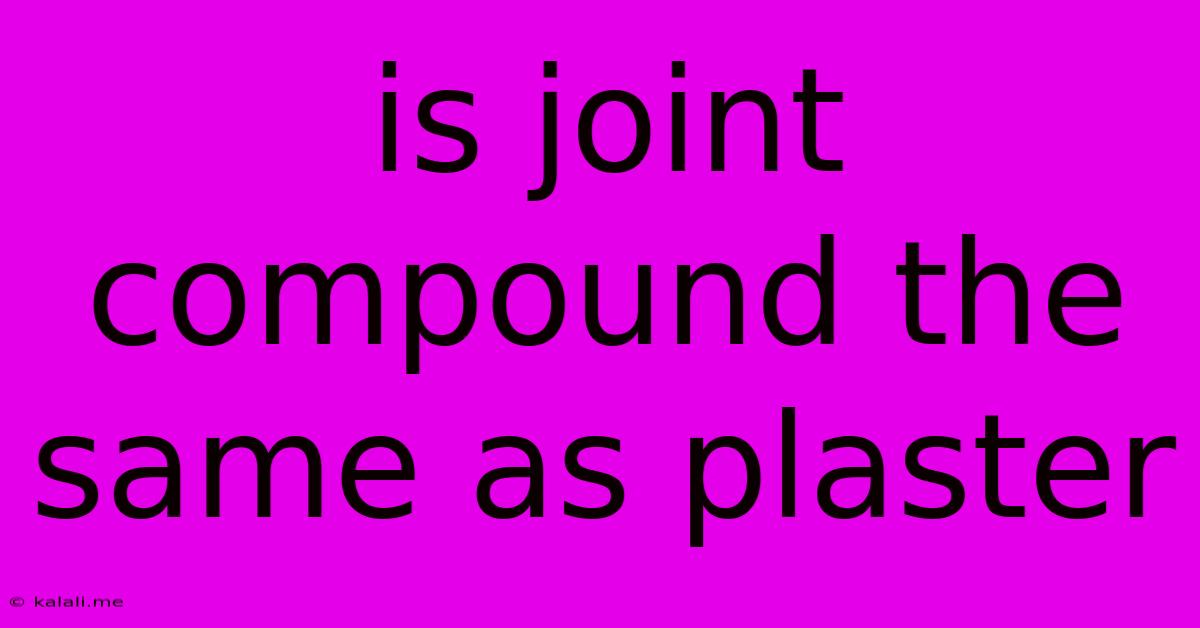Is Joint Compound The Same As Plaster
Kalali
May 31, 2025 · 3 min read

Table of Contents
Is Joint Compound the Same as Plaster? Understanding the Differences
So, you're tackling a home improvement project and you're faced with a wall full of holes, or perhaps you're preparing for a fresh coat of paint. You've heard of joint compound and plaster, and you might be wondering – are they the same thing? The short answer is no, but the longer answer is a bit more nuanced and involves understanding their distinct properties, applications, and drying times. This article will clarify the differences between joint compound and plaster, helping you choose the right material for your project.
Joint compound, also known as drywall compound or mud, is a paste-like material primarily used to finish drywall. It's designed to fill gaps, seams, and screw holes in drywall, creating a smooth, paintable surface. Plaster, on the other hand, is a traditional building material used for coating walls and ceilings, often used in older homes. It’s a much harder material and has a distinct texture.
Key Differences Between Joint Compound and Plaster
Here's a breakdown of the key distinctions between these two materials:
1. Composition: Joint compound is typically made from gypsum, water, and various additives to improve its workability and drying time. Plaster's composition can vary, but often includes gypsum, lime, and aggregates like sand. This difference in composition leads to significant differences in texture and application.
2. Application: Joint compound is applied with a putty knife or taping knife, in thin coats. It's designed for relatively smooth, even surfaces. Plaster, traditionally applied by hand, often requires more skill and is applied in thicker layers. Techniques like plastering and rendering require specific expertise.
3. Drying Time: Joint compound dries relatively quickly, usually within a few hours, depending on the thickness of the application and environmental conditions. Plaster takes significantly longer to dry, sometimes several days.
4. Durability: Joint compound is suitable for interior walls and ceilings and provides a smooth finish for painting. Plaster, due to its harder composition, offers greater durability and can withstand more wear and tear, making it ideal for areas exposed to moisture or impact.
5. Texture: Joint compound provides a very smooth, fine texture after drying and sanding. Plaster, depending on the type and application technique, can have a range of textures, from smooth to highly textured. Consider the desired finish before selecting the appropriate material.
6. Cost: Joint compound is generally less expensive than plaster.
Choosing the Right Material
The best material for your project depends entirely on the task.
-
Use Joint Compound for:
- Filling nail holes in drywall
- Taping drywall seams
- Creating a smooth surface for painting
- Interior wall repairs
-
Use Plaster for:
- Creating decorative wall finishes
- Restoring old plaster walls
- Exterior wall applications (some specialized plasters)
- Achieving a textured wall finish
Understanding these differences will ensure you select the correct material for your project, leading to a successful and professional-looking finish. Remember to always follow the manufacturer's instructions for application and drying times. If you're unsure which material to use, it's always best to consult a professional contractor.
Latest Posts
Latest Posts
-
How To Idex A Removable Disk
Jun 02, 2025
-
How To Make A Single Player World Multiplayer Minecraft Java
Jun 02, 2025
-
Do I Need A Summary Detailed Description In Provisional A Tent
Jun 02, 2025
-
Fare Thee Well Meaning In Death
Jun 02, 2025
-
Cheapest Way To Get Into Magic The Gathering
Jun 02, 2025
Related Post
Thank you for visiting our website which covers about Is Joint Compound The Same As Plaster . We hope the information provided has been useful to you. Feel free to contact us if you have any questions or need further assistance. See you next time and don't miss to bookmark.